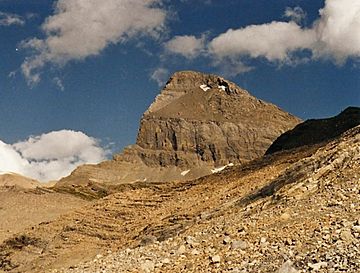Mount Niles facts for kids
Quick facts for kids Mount Niles |
|
|---|---|

Mount Niles
|
|
| Highest point | |
| Elevation | 2,967 m (9,734 ft) |
| Prominence | 362 m (1,188 ft) |
| Parent peak | Mount Daly (3148 m) |
| Listing | Mountains of British Columbia |
| Geography | |
| Location | Yoho National Park British Columbia, Canada |
| Parent range | Waputik Range Canadian Rockies |
| Topo map | NTS 82N09 |
| Geology | |
| Age of rock | Cambrian |
| Type of rock | sedimentary rock |
| Climbing | |
| First ascent | 1898 D. Campbell, C.E. Fay |
| Easiest route | Scramble |
Mount Niles is a tall mountain located in Yoho National Park, British Columbia, Canada. It stands 2,967-metre (9,734-foot) high in the Waputik Range of the Canadian Rockies. This mountain is close to Mount Daly, which is even taller. You can find Takakkaw Falls not far away, and the huge Waputik Icefield to the north. Sherbrooke Lake is located to the south.
The Story Behind Mount Niles' Name
A man named Charles Sproull Thompson gave Mount Niles its name in 1898. He named it after William H. Niles, who was a geology professor. William Niles also led a group called the Appalachian Mountain Club. He enjoyed climbing mountains in this area too.
The very first time someone successfully climbed to the top of Mount Niles was also in 1898. This climb was made by D. Campbell and Charles Ernest Fay. The mountain's name became official in 1924. The Geographical Names Board of Canada approved it.
What Mount Niles is Made Of
Mount Niles is made of a type of rock called sedimentary rock. This rock formed a very long time ago, from the Precambrian to the Jurassic periods. Sedimentary rock forms from layers of sand, mud, and tiny bits of sea creatures. These layers build up over millions of years.
These rocks were once at the bottom of shallow seas. Later, a huge event called the Laramide orogeny pushed them up. This event created the Canadian Rockies mountains.
Weather and Climate Around Mount Niles
Mount Niles is in a subarctic climate zone. This means it has cold, snowy winters and mild summers. Temperatures can drop very low, sometimes below −20 °C. With the wind, it can feel even colder, below −30 °C.
Rain and melting snow from Mount Niles flow into the Yoho River. They also flow into Niles Creek. Both of these are smaller rivers that join the larger Kicking Horse River.



